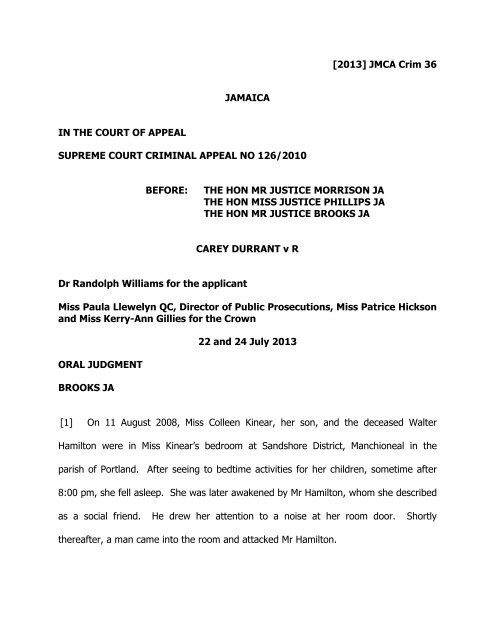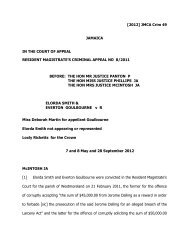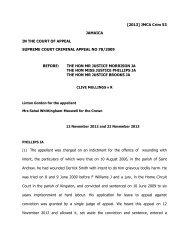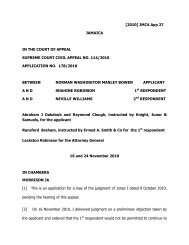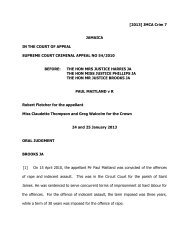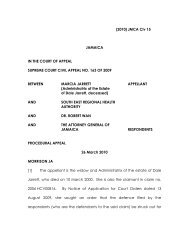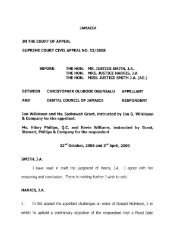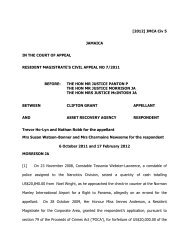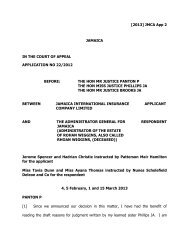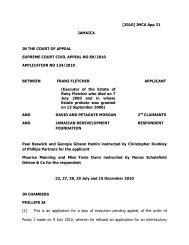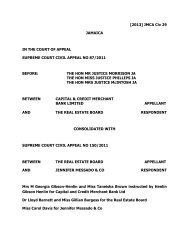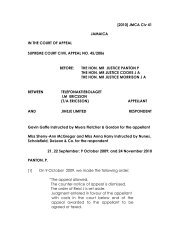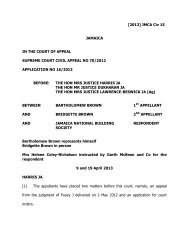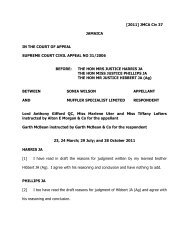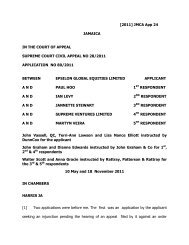Durrant (Carey) v R.pdf - The Court of Appeal
Durrant (Carey) v R.pdf - The Court of Appeal
Durrant (Carey) v R.pdf - The Court of Appeal
You also want an ePaper? Increase the reach of your titles
YUMPU automatically turns print PDFs into web optimized ePapers that Google loves.
[2013] JMCA Crim 36<br />
JAMAICA<br />
IN THE COURT OF APPEAL<br />
SUPREME COURT CRIMINAL APPEAL NO 126/2010<br />
BEFORE:<br />
THE HON MR JUSTICE MORRISON JA<br />
THE HON MISS JUSTICE PHILLIPS JA<br />
THE HON MR JUSTICE BROOKS JA<br />
CAREY DURRANT v R<br />
Dr Randolph Williams for the applicant<br />
Miss Paula Llewelyn QC, Director <strong>of</strong> Public Prosecutions, Miss Patrice Hickson<br />
and Miss Kerry-Ann Gillies for the Crown<br />
ORAL JUDGMENT<br />
BROOKS JA<br />
22 and 24 July 2013<br />
[1] On 11 August 2008, Miss Colleen Kinear, her son, and the deceased Walter<br />
Hamilton were in Miss Kinear’s bedroom at Sandshore District, Manchioneal in the<br />
parish <strong>of</strong> Portland. After seeing to bedtime activities for her children, sometime after<br />
8:00 pm, she fell asleep. She was later awakened by Mr Hamilton, whom she described<br />
as a social friend. He drew her attention to a noise at her room door. Shortly<br />
thereafter, a man came into the room and attacked Mr Hamilton.
[2] She recognized the man to be the applicant, Mr <strong>Carey</strong> <strong>Durrant</strong>, who is the father<br />
<strong>of</strong> one <strong>of</strong> her children. She said that Mr <strong>Durrant</strong> pushed Mr Hamilton against a wall in<br />
the room and there the two struggled. During the struggle, Mr <strong>Durrant</strong> appeared to be<br />
thumping Mr Hamilton. Miss Kinear tried to intervene, attempting to pull Mr <strong>Durrant</strong> <strong>of</strong>f<br />
Mr Hamilton but Mr <strong>Durrant</strong> pushed her away. When Mr Hamilton’s resistance ceased,<br />
Mr <strong>Durrant</strong> turned his attention toward her. He attacked her, stabbing her in the chest.<br />
He then jumped on the bed that was in the room, knocked open her window and<br />
jumped through the resulting aperture.<br />
[3] Miss Kinear realised that she had been stabbed. She saw Mr Hamilton on the<br />
ground bleeding, and then went to her sister’s room, which is in the same house, for<br />
help.<br />
She received assistance and was taken to the hospital where she received<br />
treatment. She gave a report to the police while she was in hospital. Mr Hamilton,<br />
however, succumbed to his injuries.<br />
[4] At about 2:00 am on 12 August 2008, scenes <strong>of</strong> crime <strong>of</strong>ficers went to Miss<br />
Kinear’s house and observed the lighting conditions and other circumstances in her<br />
room. <strong>The</strong> <strong>of</strong>ficers reclosed the window as part <strong>of</strong> their attempt to recreate the lighting<br />
conditions in the room at the time <strong>of</strong> the attack.<br />
[5] Mr <strong>Durrant</strong> was arrested on 18 September 2008. He was tried on an indictment<br />
for the <strong>of</strong>fence <strong>of</strong> murder in the Circuit <strong>Court</strong> for the parish <strong>of</strong> Portland. His defence at<br />
the trial was a denial <strong>of</strong> the charge. He gave an unsworn statement in which he said<br />
that he did not go to Miss Kinear’s home at anytime and that he did not stab anyone.
[6] <strong>The</strong> jury, by its verdict, rejected Mr <strong>Durrant</strong>’s account and accepted Miss<br />
Kinear’s. He was convicted on 2 December 2010 and was sentenced by the learned<br />
trial judge to serve imprisonment for life at hard labour. He was, however, ordered to<br />
serve not less than 25 years before being eligible for parole.<br />
[7] He applied for leave to appeal against his conviction and sentence. His<br />
application was considered by a single judge <strong>of</strong> this court who refused him permission<br />
to appeal, but recommended that he be afforded legal aid assistance. Mr <strong>Durrant</strong> has<br />
renewed his application before the court and Dr Williams appeared on his behalf in that<br />
regard.<br />
[8] <strong>The</strong> grounds <strong>of</strong> appeal which Mr <strong>Durrant</strong> had originally filed were headed as<br />
follows:<br />
1. Unfair trial<br />
2. Lack <strong>of</strong> evidence<br />
3. Miscarriage <strong>of</strong> justice<br />
4. Personnel [sic] vendetta<br />
[9] Dr Williams, having reviewed these matters has conceded that the grounds <strong>of</strong><br />
appeal are without merit. He did indicate that he had some concerns with the fact that<br />
the main witness for the prosecution, Miss Kinear, had first pointed out Mr <strong>Durrant</strong> at<br />
the preliminary enquiry. In those circumstances, he argued, that identification may be<br />
deemed a dock identification.
[10] Learned counsel conceded, however, that bearing in mind the relationship<br />
between Miss Kinear and Mr <strong>Durrant</strong>, the principle whereby an identification parade<br />
should be held only where it would serve a useful purpose (Goldson and McGlashan<br />
v R [2000] UKPC 9 (23 March 2000)), would apply. <strong>The</strong>re would, therefore, be no<br />
point, Dr Williams agreed, in the learned trial judge addressing the jury on the issue <strong>of</strong><br />
dock identification.<br />
[11] In the instant case, Miss Kinear and Mr <strong>Durrant</strong> had lived as husband and wife<br />
for some four years before they parted company.<br />
<strong>The</strong>re is no doubt in those<br />
circumstances, therefore, that an identification parade would have served absolutely no<br />
purpose. Indeed, it appears that she had given his name to the police at the time she<br />
gave her statement, while in the hospital.<br />
[12] It is noted that at the trial much time was spent on the ambient lighting in Miss<br />
Kinear’s bedroom at the time <strong>of</strong> the attack.<br />
<strong>The</strong> evidence <strong>of</strong> the scenes <strong>of</strong> crime<br />
<strong>of</strong>ficers was supportive <strong>of</strong> her evidence that the lighting would have allowed her to view<br />
the features <strong>of</strong> the attacker and to recognise the person if it were someone with whom<br />
she was familiar.<br />
[13] It is noted that the learned trial judge, in addressing the jury on the issue <strong>of</strong><br />
inconsistencies varied somewhat from the guidance given by the authorities, in that he<br />
gave his directions in the context <strong>of</strong> the central issue. He said at pages 298-299 <strong>of</strong> the<br />
transcript:
“So when you come to address an inconsistency, for<br />
example, a witness not saying something on a previous<br />
occasion and saying something different on other occasion,<br />
you have to ask yourself the question, is this really<br />
important having regard to the central issue, or is it<br />
something that really is not important Does this really go<br />
to the heart <strong>of</strong> the case or is this something I can safely<br />
overlook and put aside and say it is something relatively<br />
minor in the scheme <strong>of</strong> things. If it goes to the heart <strong>of</strong> the<br />
case, then <strong>of</strong> course, it would be open to you to say whether<br />
this witness is not reliable and this witness is lying when it<br />
comes to this important fact and it will be open for you to<br />
reject all that witness has to say. On the other hand, [if] it<br />
does not go to the heart <strong>of</strong> the case and it does not affect<br />
the central issue, then it will be open to you to regard it as<br />
unimportant, something light, something not serious and go<br />
on to consider and focus on what is the central issue in the<br />
case. I should point out as well, you are not required to<br />
accept everything a witness says, or to reject everything a<br />
witness says. If you find an inconsistency on [sic] part <strong>of</strong><br />
the witness’ testimony, it is open to you to accept some part<br />
<strong>of</strong> what a witness says and reject another part, you must<br />
also bear in mind what is the central issue in this case.”<br />
[14] This court, in the case <strong>of</strong> R v Lenford Clarke SCCA No 74/2004 (delivered on<br />
29 July 2005), was somewhat critical <strong>of</strong> that method <strong>of</strong> approach. Smith JA, in<br />
delivering the judgment <strong>of</strong> the court, said in respect <strong>of</strong> this issue:<br />
“In our view restricting the consideration <strong>of</strong> inconsistencies to<br />
the so-called central issue is not helpful and may indeed be<br />
confusing to the jury.<br />
Invariably the so-called ‘central issue’ in a case involves<br />
many material issues. A witness might speak to one or more<br />
<strong>of</strong> these issues. Whether or not an inconsistency is material<br />
would, we venture to think, depend on the nature, degree<br />
and relevance <strong>of</strong> the inconsistency. Where, for example,<br />
credibility is in issue, discrepancies in respect <strong>of</strong> peripheral<br />
matters may be relevant and thus, we think, material. On<br />
the other hand a discrepancy or conflict may be in respect <strong>of</strong>
a material issue but its degree de minimis and so<br />
insignificant that the discrepancy may properly be regarded<br />
as slight or immaterial.”<br />
[15] <strong>The</strong> departure by the learned trial judge, from that guidance, would not,<br />
however, have confused the jury in this case and would not have caused a miscarriage<br />
<strong>of</strong> justice.<br />
[16] Having perused the documentation, and having heard from both Dr Williams and<br />
the learned Director <strong>of</strong> Public Prosecutions, for the Crown, we are satisfied that the<br />
learned trial judge properly directed the jury on the issues <strong>of</strong> identification and<br />
credibility. He placed those matters squarely before the jury for its consideration and<br />
the jury returned its verdict on those bases.<br />
[17] Based on those findings, the application is refused and the sentence imposed<br />
must be reckoned as having commenced on 2 December 2010.


